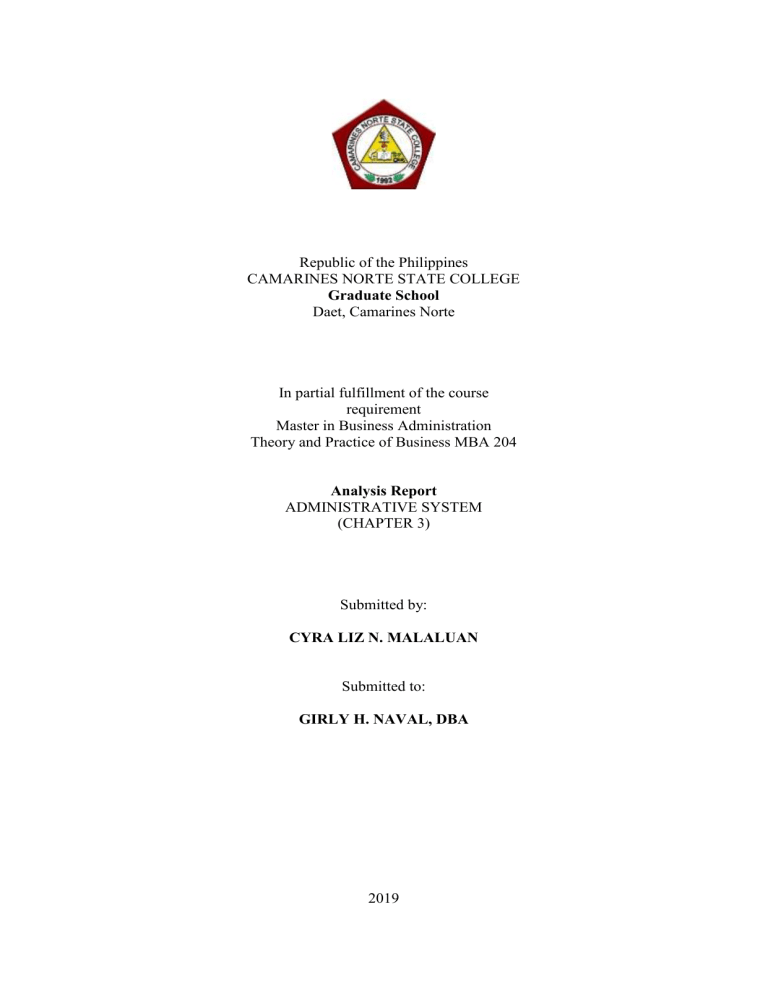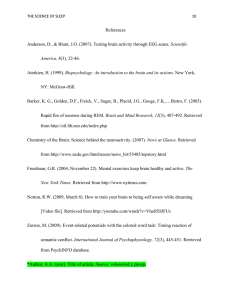
Republic of the Philippines CAMARINES NORTE STATE COLLEGE Graduate School Daet, Camarines Norte In partial fulfillment of the course requirement Master in Business Administration Theory and Practice of Business MBA 204 Analysis Report ADMINISTRATIVE SYSTEM (CHAPTER 3) Submitted by: CYRA LIZ N. MALALUAN Submitted to: GIRLY H. NAVAL, DBA 2019 ADMINISTRATIVE SYSTEM Discussion to topic: Administrative System this are a set or system of rules that govern the procedure for managing an organization. These procedures are meant to establish efficiency, consistency, responsibility and accountability. It also describes the interrelationships which exist among 5 fields of inquiry traditionally treated separately in the literature on administration and management: 1. 2. 3. 4. 5. Organizational design Organizational strategy Organizational values Motivation Management control Organizational design is a step-by-step methodology which identifies dysfunctional aspects of work flow, procedures, structures and systems, realigns them to fit current business realities/goals and then develops plans to implement the new changes. The process focuses on improving both the technical and people side of the business. To achieve: Excellent customer service Increased profitability Reduced operating costs Improved efficiency and cycle time A culture of committed and engaged employees A clear strategy for managing and growing your business This approach to redesign results in dramatic improvements in quality, customer service, decreased cycle times, lower turnover and absenteeism, productivity gains from 25 to at least 50%, etc. The good news is that it can be used in most any type and size of business. The length of time required to complete a redesign varies depending on the nature, size and resources of the organization. Large and complex redesign projects can be completed within several days. Smaller organizations require much less time and fewer resources. An Organizational Strategy is the sum of the actions a company intends to take to achieve long-term goals. Together, these actions make up a company’s strategic plan. Strategic plans take at least a year to complete, requiring involvement from all company levels. Top management creates the larger organizational strategy, while middle and lower management adopt goals and plans to fulfill the overall strategy step by step. This unified effort to can be likened to a journey. Daily challenges such as road conditions must be overcome to complete sequential legs of the journey, which eventually lead to the ultimate destination. Organizational Values describe the core ethics or principles which the company will abide by, no matter what. They inspire employees’ best efforts and also constrain their actions. Strong, clearly-articulated values should be a true reflection of your organization’s aspirations for appropriate workplace behavior, and play an important role in building a positive culture at your organization. Well-drafted and current organizational values: Guide staff behavior, as well as strategic and operational decisions Provide a solid foundation for your employment policies, and “fill the gaps” where policies are silent Over time, improve the organization’s ethical character as expressed in its operations and culture Demonstrate integrity and accountability to external stakeholders Set the organization apart from its competitors Reduce risk of inappropriate behavior Strengthen the employment value proposition Every organization preference some values over others. A university might value intellectual rigor, independence and the pursuit of knowledge. By comparison, a listed telecommunications company would prefer customer service, network reliability, and profit. For this reason, there is no such thing as a one-size-fits-all Code of Ethics. Why define your organizational values and ethics? Employees often rate the company’s “vision, culture and values” as the most important factor in determining how they perceive their employer. Research also indicates that companies which demonstrate a coherent set of ethical principles are more likely to be profitable and stand the test of time. Motivation is the reason for people's actions, willingness and goals. These needs could be wants or desires that are acquired through influence of culture, society, lifestyle, etc. or generally innate. Motivation is one's direction to behaviour, or what causes a person to want to repeat a behaviour, a set of force that acts behind the motives. An individual's motivation may be inspired by others or events (extrinsic motivation) or it may come from within the individual (intrinsic motivation). Motivation has been considered as one of the most important reasons that inspires a person to move forward in life. Motivation results from the interaction of both conscious and unconscious factors. Mastering motivation to allow sustained and deliberate practice is central to high levels of achievement e.g. in the worlds of elite sport, medicine or music. Management Control can be defined as a systematic effort by business management to compare performance to predetermined standards, plans, or objectives in order to determine whether performance is in line with these standards and presumably in order to take any remedial action required to see that human and other corporate resources are being used in the most effective and efficient way possible in achieving corporate objectives. Application/Personal Insight Administrative System are the rules and regulations that each organization follow. Not having an administrative system may lead to the failure and chaos in the organization. Also as time passes by we need to modify this system, it is because we need to innovate the old systems as time changes. It is in order to make the organization survive. Having a well-defined system may lead to attract more customer, it may increase the organizations cash flow, and it will also increase the productivity of the employees. It will lead to attract more customer because once that they are being satisfied in your service they might tell it to other people and by that those people who heard about your good service are the potential clients. Because they heard that the organization has a good service then definitely they will try your service in order for them to know if it is true, and once proven they will patronize the organization. It may increase the organizations cash flow, because if there are more customer then probably more income more cash flow for the organization. But always see to it that it should be monitor because negligence of the one who monitors may lead to big problem and loss of money. The cash inflow should always be higher than the cash out flow. It will increase the productivity of the employees because they are happy and motivated to the system that the organization has. It is also important to modify the existing systems it is because we need to go along the competition, in this way we can survive. If we will not modify the existing system, then we may lose the competition. A good example for this is the filing of bankruptcy of Forever 21. This is because in this generation online selling are the trend. The said brand didn’t modify and go with the trend of trying to enter into online selling or making a website to sell their product instead they still push for the expansion and opening more branches all over the world. And because of that hesitation in trying to modify their administrative system they are now in debt in almost billion dollars. Conclusion To sum it up administrative system plays a big part in an organization. Not having a well-planned and well-defined administrative system may lead to the failure and incompetency of the organization. Also without proper planning, delegation, allocating of resources, modification of the existing business and proper implementation it may also result to a big problem in the organization. That is why it is important in doing the policies to execute and follow the 5 fields the organizational design, strategy, values, motivation and management control. Also they are important because they provide an objective set of rules by which an organization is governed. They also help establish the legitimacy of management action by ensuring the application of management rules and decision is done in an objective, fair, and consistent manner. Finally, they help ensure that managers are held accountable for decision s that deviate from the procedures. References David W.Y (2002 May) Administrative ciencedirect.com/science/article/pii/036136827990028x System retrieved from s - Accounting, Organizations and Society volume 4, Issue 3, 1979, pages 235-244 - Industrial Marketing Management volume 42, Issue 3, April 2013, pages 433-442 Shawn G. (2018) Administrative Procedures retrieved from www.//study.com/academy/lesson/what-are-administrative-procedures-definition-lessonquiz.html Dr. Roger K.A (2015) Organizational www.//centerod.com/2012/02/what-is-organizational-design/ design retrieved from Sophie J. (2019 March) Organizational strategy retrieved www.//smallbusiness.chron.com/meaning-organizational-strategy-59427.html from - Organizational values retrieved from www.//worklogic.com.au/services-organisationalvalues/ - Motivation retrieved from en.m.wikipedia.org/wiki/motivation - Management Control retrieved from en.m.wikipedia.org/wiki/control_(management) - Management Control retrieved from www.businessdictionary.com/definition/managementcontrol.html - Kaitlyn W. and Irene K. (2019 September) Forever 21 files for bankruptcy retrieved from amp.businessibsider.com/forever-21-bankruptcy-rise-fall-retail-apocalypse-fast-fashion2019-9



